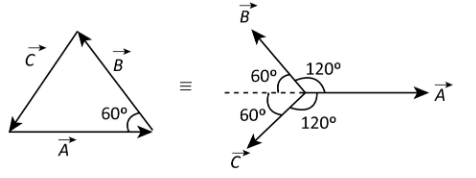
The magnitude of resultant of three vectors of magnitude 1, 2 and 3 whose direction are those of the sides of an equilateral triangle taken in order is:
A.
B.
C.
D.
Answer
463.5k+ views
Hint: First, simplified and shift the vectors by connecting the tails of each vector and then break the vectors in the rectangular components in the form of
Complete step by step answer:
From the question, we know that the magnitude of the three vectors are

Now write the all vectors in terms of direction
From the figure, we know that the vectors
The vector
Substitute the values in the above equation, we get,
The vector
Substitute the values in the above equation, we get,
Now we calculate the sum of the three vectors, we have,
Now, we calculate the magnitude of the three vectors,
After simplifying the above equation, we have,
After simplifying the above equation, we get
Thus, the magnitude of the resultant of three vectors of magnitude 1, 2 and 3 is
Note:Make sure the triangles are formed by connecting the head of one vector with the tail of another vector and while splitting the vectors in the rectangular components, make sure you add minus in for leftwards and downward direction. Only
Complete step by step answer:
From the question, we know that the magnitude of the three vectors are

Now write the all vectors in terms of direction
From the figure, we know that the vectors
The vector
Substitute the values in the above equation, we get,
The vector
Substitute the values in the above equation, we get,
Now we calculate the sum of the three vectors, we have,
Now, we calculate the magnitude of the three vectors,
After simplifying the above equation, we have,
After simplifying the above equation, we get
Thus, the magnitude of the resultant of three vectors of magnitude 1, 2 and 3 is
Note:Make sure the triangles are formed by connecting the head of one vector with the tail of another vector and while splitting the vectors in the rectangular components, make sure you add minus in for leftwards and downward direction. Only
Latest Vedantu courses for you
Grade 11 Science PCM | CBSE | SCHOOL | English
CBSE (2025-26)
School Full course for CBSE students
₹41,848 per year
Recently Updated Pages
Master Class 11 Economics: Engaging Questions & Answers for Success

Master Class 11 Business Studies: Engaging Questions & Answers for Success

Master Class 11 Accountancy: Engaging Questions & Answers for Success

Master Class 11 English: Engaging Questions & Answers for Success

Master Class 11 Computer Science: Engaging Questions & Answers for Success

Master Class 11 Maths: Engaging Questions & Answers for Success

Trending doubts
State and prove Bernoullis theorem class 11 physics CBSE

1 ton equals to A 100 kg B 1000 kg C 10 kg D 10000 class 11 physics CBSE

State the laws of reflection of light

One Metric ton is equal to kg A 10000 B 1000 C 100 class 11 physics CBSE

1 Quintal is equal to a 110 kg b 10 kg c 100kg d 1000 class 11 physics CBSE

Difference Between Prokaryotic Cells and Eukaryotic Cells




